The first Global Bamboo and Rattan Congress, BARC 2018, opened on 25th June 2018, in Beijing, China. Although it is already two months ago, I want to use this moment to reflect on BARC 2018, as it consumed most of my time during the first half of the year.
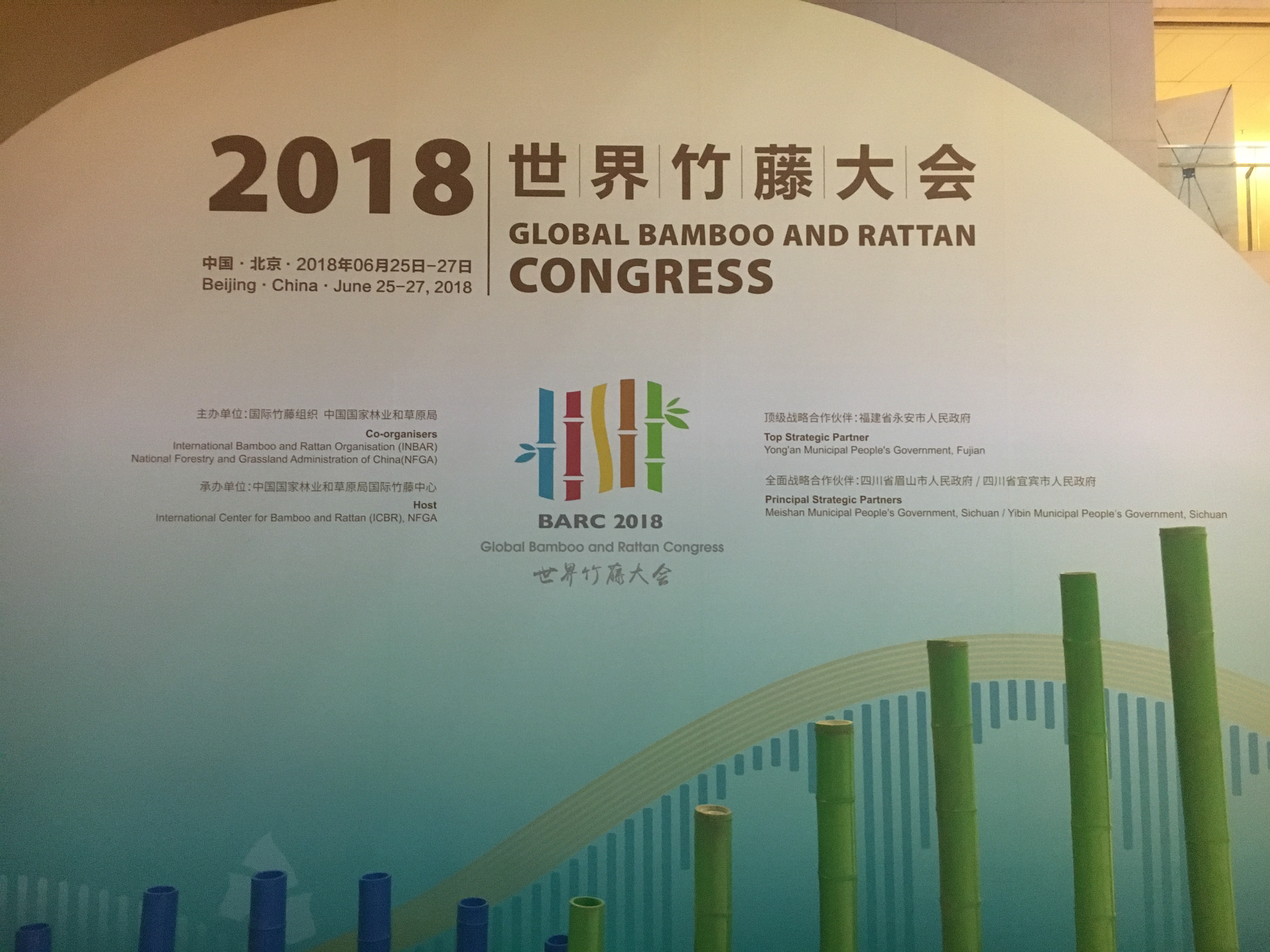
The three-day event, co-hosted by the International Bamboo and Rattan Organisation (INBAR) and China’s National Grassland and Forestry Administration, welcomed (many) more than 1200 participants from 70 countries, including Ministers, policymakers and representatives from research institutes, development organisations, UN bodies and the private sector.

Over the course of three days, participants could choose to attend a ministerial summit, three high-level dialogues – which covered South-South cooperation, climate change, and innovation and industry development – and around 80 parallel sessions. The overarching theme of the Congress was “Enhancing South-South Cooperation for Green Development through Bamboo and Rattan’s Contribution to the Sustainable Development Goals”.

Overall, BARC 2018 was a great success. Bamboo and rattan are critical resources, but still grossly under-used. Fast-growing and local to some of the poorest communities in the tropics and subtropics, bamboo and rattan are used around the world in simple construction and as household utensils, but BARC 2018 illustrated that they could provide much more. Discussions included how to realise bamboo and rattan’s huge potential in a number of areas: sustainable commodity production, disaster-resilient construction, poverty alleviation, climate change mitigation and adaptation, land restoration and biodiversity protection.

I was very happy that BARC 2018 was not a stand-alone activity, but it followed the INBAR Strategy 2015 – 2030. The strategy has four components: Policy advice, membership and partnership, information and technology sharing, and real action on the ground. In my view, BARC 2018 supported these four objectives.
With regards to policy advice, we managed to raise the profile, especially amongst a new group of stakeholders. Our aim is to help members to achieve their Sustainable Development Goals, and that means reaching out beyond the world of forestry and foresters. BARC 2018 involved many participants who were not “bamboo or rattan specialists”, and we managed to show new partners what amazing opportunities bamboo can provide. This will directly and indirectly influence policy.
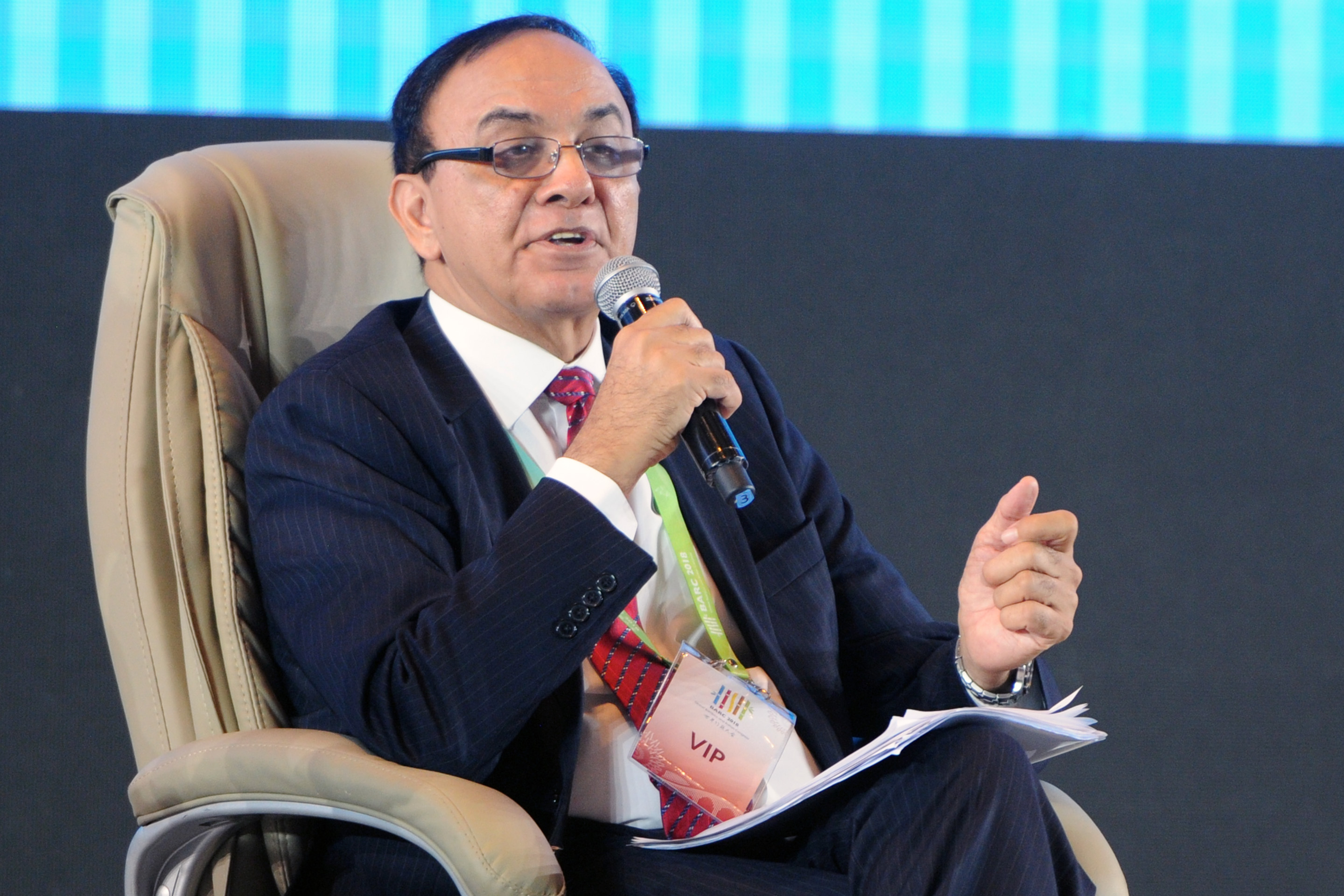
Dr Pradeep Monga, Deputy Executive Secretary , UN Convention to Combat Desertification
For example, we worked with UN Women to highlight the gender aspects of bamboo and rattan; we had key-note speakers from UN Conventions and the International Fund for Agricultural Development (IFAD) who had not heard of INBAR before they joined us; we listened to parliamentarians from Ethiopia, Philippines and Uganda; we learned from global thinkers from the Club of Rome like Gunter Pauli, Fred Dubee and Jinfeng Zhou.
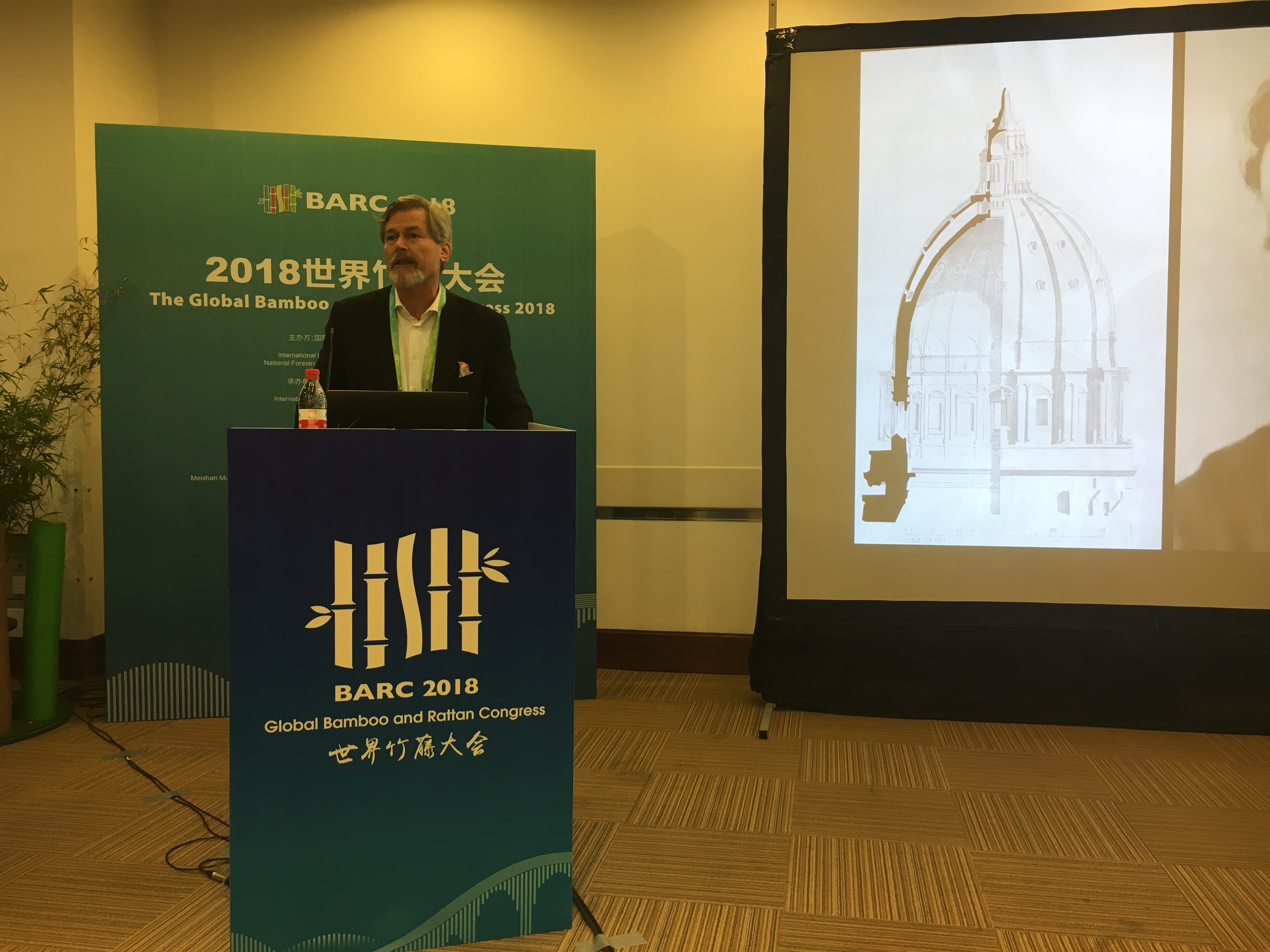
Gunter Pauli
The opening of BARC 2018 included congratulatory messages from Heads of State from China, Colombia and Ecuador, and from the UNDP Administrator Achim Steiner and the Director-Deneral of FAO Graziano da Silva. The Congress also launched the Beijing Declaration, which recognizes bamboo and rattan’s various benefits, and commits “ministers, senior officials and participants” to calling upon national governments and other bodies to implement a number of recommendations.
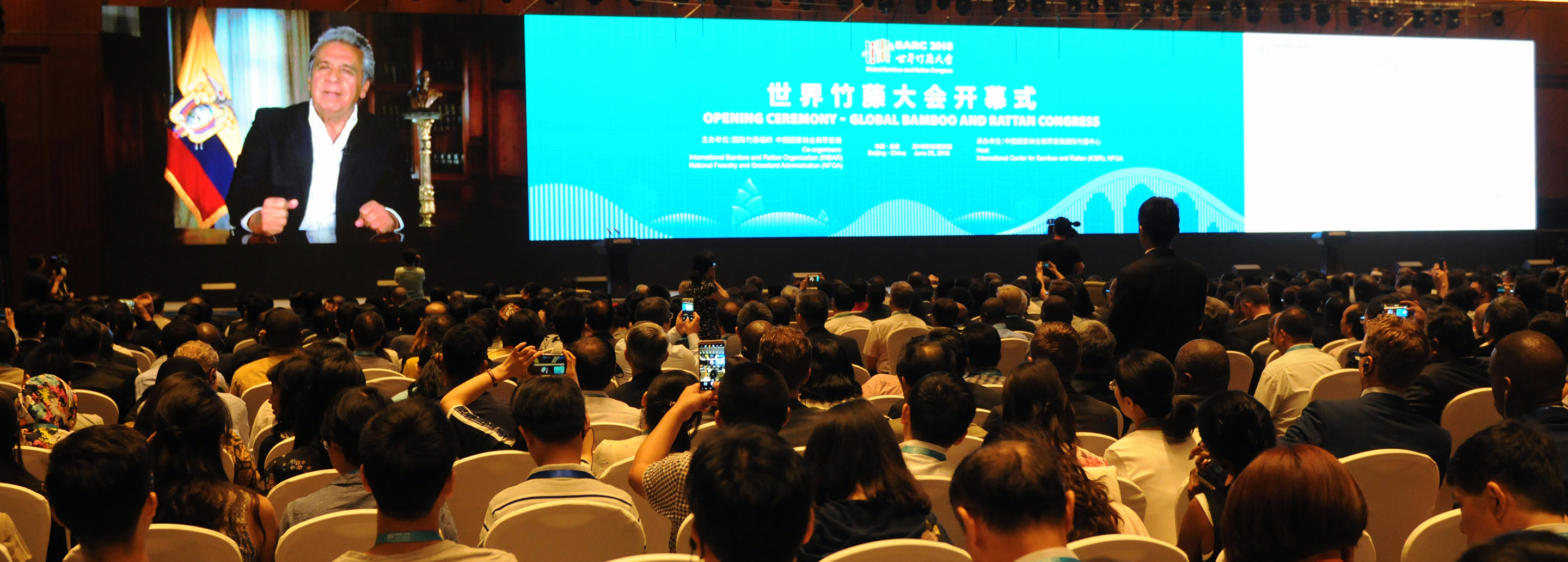
Video message from Nobel Laureate and former President of Colombia, HE Juan Manuel Santos
With regards to membership support, we used this Congress very effectively for South-South Cooperation, and all our members were very happy to share their experiences and learn from each other. We even announced a new INBAR Member – Central Africa Republic.

We must have had several hundred representatives from our Member states all over the world, and in that respect BARC 2018 was a real membership-driven event. The participants included Ministers and Vice-Ministers, senior civil servants and a whole range of technical and administrative officers. I had bilateral meetings with several of the delegations, and most of the policy-makers had a speaking role in one of the plenaries or in parallel sessions.
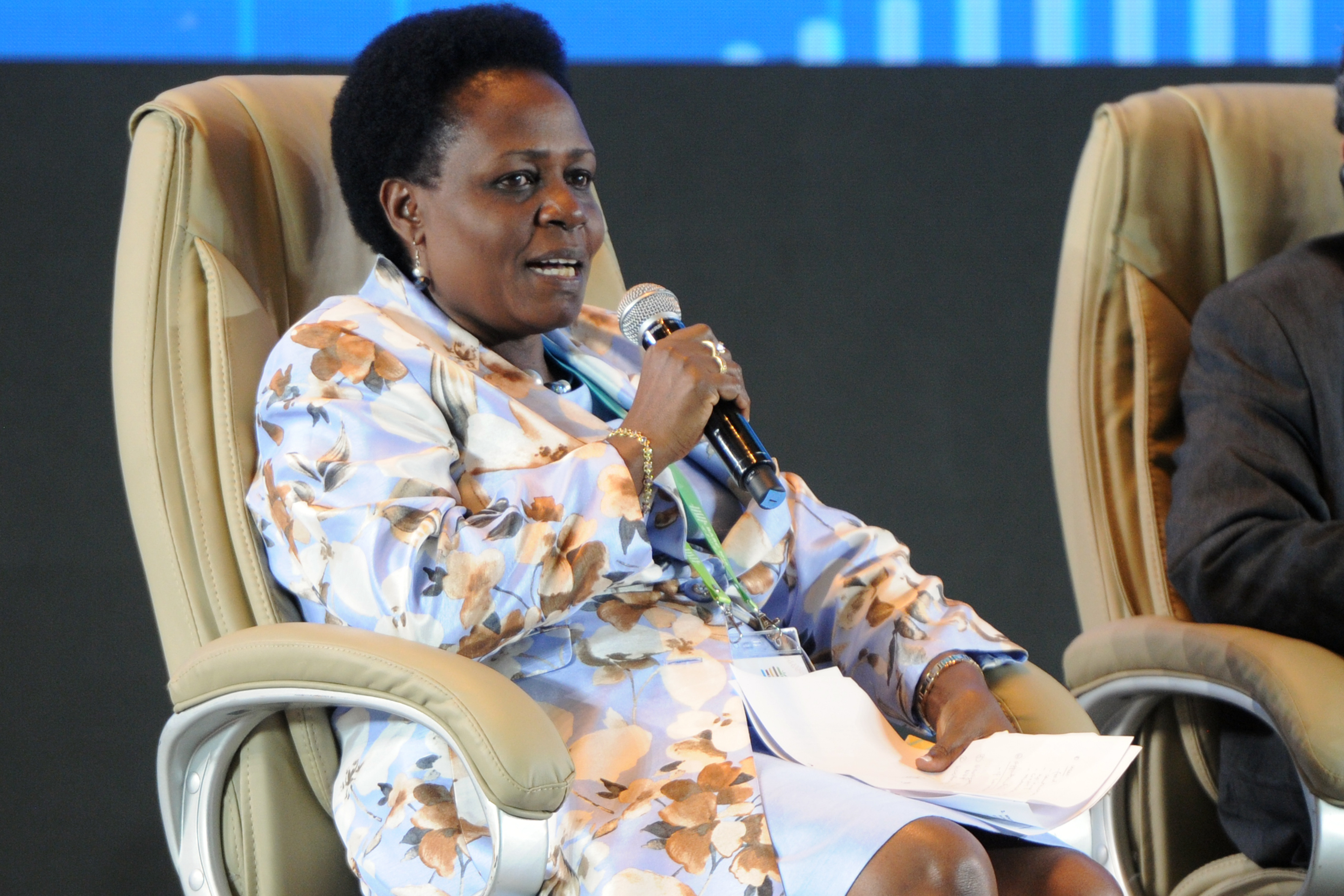
State Minister for Environment of Uganda, HE Mary Goretti Kitutu
One particular aspect that was particularly important was the opportunity to learn from China. China has such a lot to offer, but most of the information is not readily available outside of the borders. BARC was an opportunity to learn from the experiences from China, to talk with Chinese practitioners, to see Chinese products and to make contacts for future participation. One publication that was extremely valuable is the “Yellow Pages” of bamboo and rattan in China, listing just about every bamboo or rattan enterprise in the country.

Third, The Congress was a major tool to share information and innovation. We had fantastic presentations, and learned the latest developments from inside and outside of China. This included the bamboo fibre winding technology in China, but also the manufacturing of telegraph poles from bamboo in Kenya, the latest research on glues and adhesives from Australia and Ecuador and presentations about design and product development. Prof. Mme Jiang Zehui reflected on the history of bamboo research in China, and John Hardy told us about the amazing bamboo constructions in the Green School in Bali.
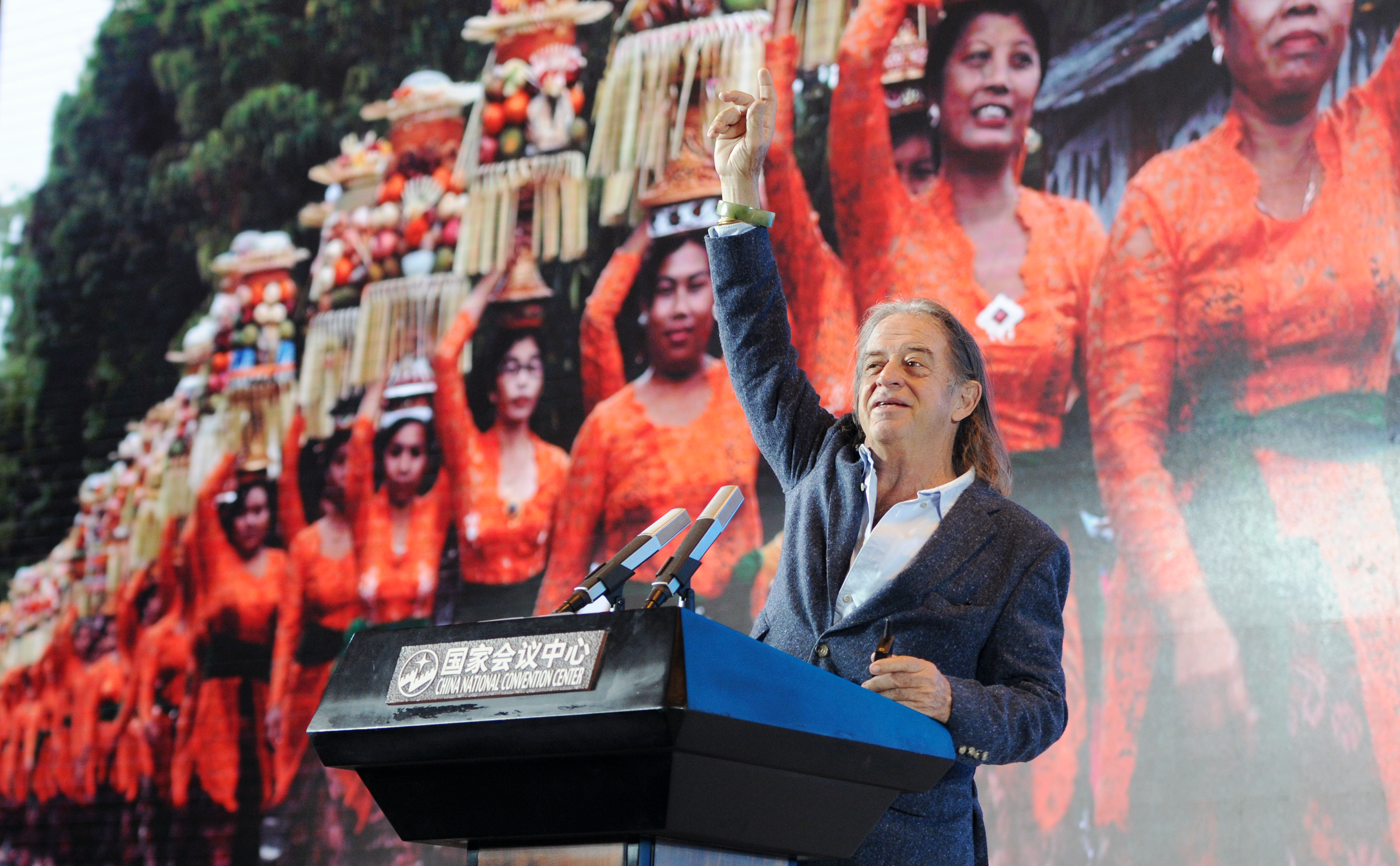
John Hardy
We also had an exhibition with amazing products, and a real eye-opener for newcomers. The “piece de resistance” for me was the blade of a wind turbine, manufactured from bamboo fibre by Tsinghua University Science Park, but we had lots of other beautiful products.


We launched INBAR-FAO-NEPAD report about bamboo for landscape restoration; we published a report about rattan terminology, prepared by the INBAR Task for on Rattan; we announced a report about subsidies for bamboo afforestation in China that was written by Zhejiang Agriculture and Forestry University; together with Delft University, we published a report about carbon storage in bamboo and we distributed the English translation of the China National Bamboo Plan 2011-2020. We also distributed “Booming Bamboo”, written by Pablo van der Lugt. This is an up-to-date review of what you can do with bamboo.
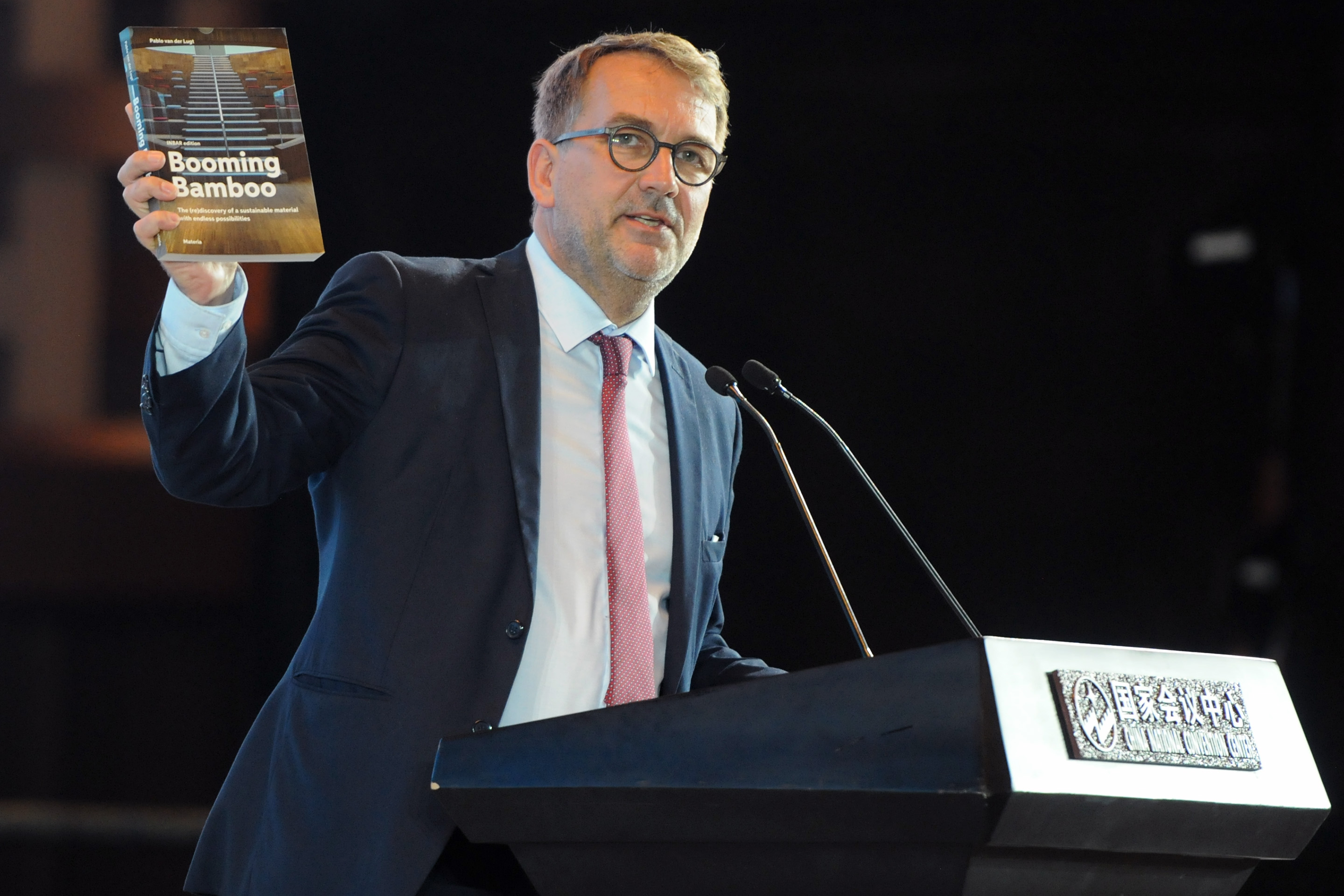
Dr Martin Frick, Senior Director, Policy and Programme Coordination, UN Framework Convention on Climate Change
Finally, we made very practical, concrete decisions to support real action. We signed agreements, had a political declaration, made new partnerships. It really was not just a talk-shop, but we build the foundations for a lot of new future work. The most important agreement that we launched was a contract with IFAD Rome to start a new intra-Africa bamboo livelihoods programme, involving Ethiopia, Cameroon, Ghana and Madagascar. I was very happy to sign this agreement with the IFAD Associate Vice-President Charlotte Salford.
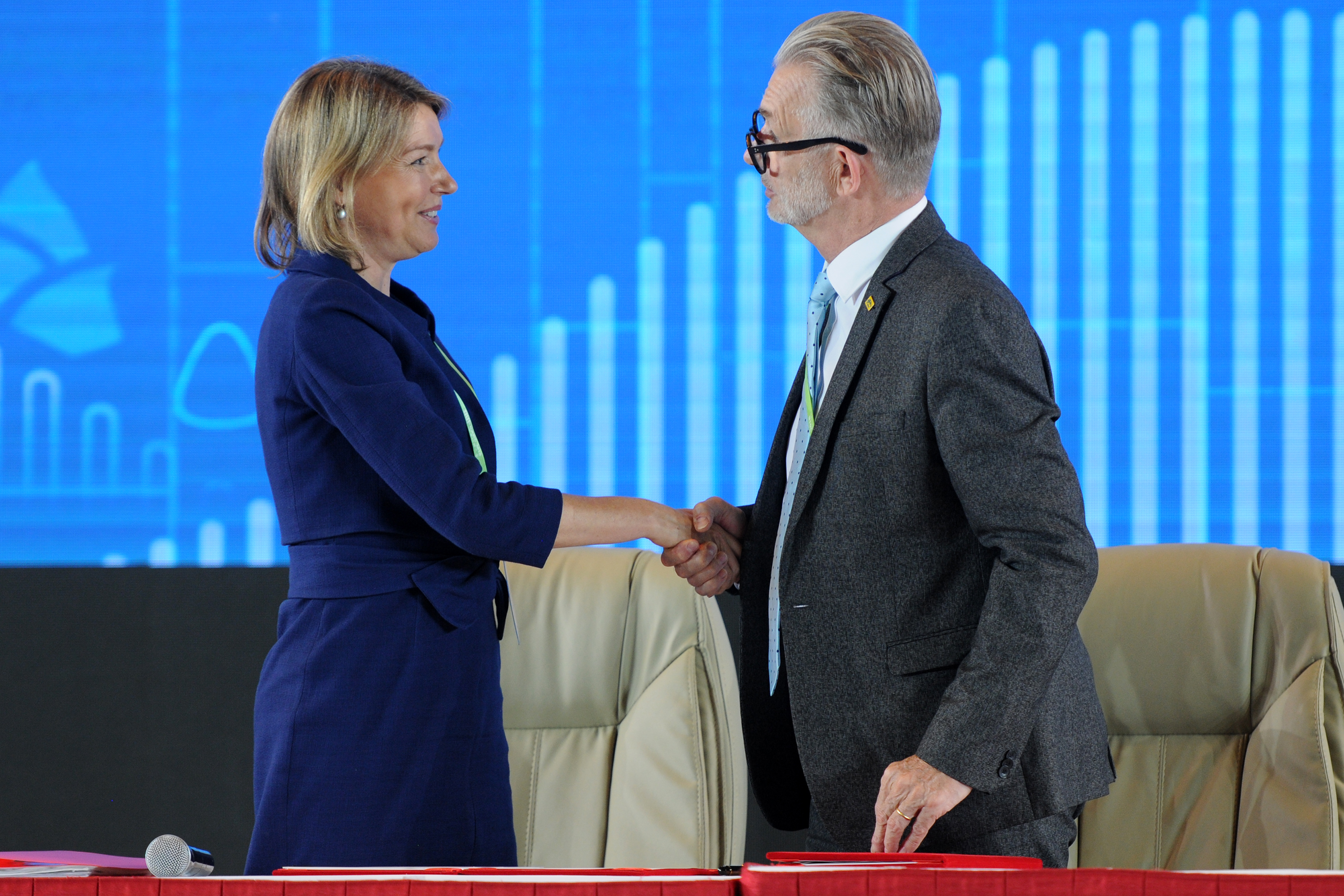
Congratulating IFAD Associate Vice-President, Ms Charlotte Salford
Other specific outcomes include a commitment from the Netherlands government to support the next phase of the Sino-Dutch bamboo project in East Africa with USD 2 million. We reached a tentative agreement to hold a 2019 planning workshop in China for Giant Panda conservation and bamboo habitat management. IFAD also confirmed financial support for a bamboo project in Colombia, Ecuador and Peru. Together with several partners we agreed to the creation of a global network of bamboo training facilities, and with FAO and potential recipient countries we discussed a large global “bamboo for climate change” project that will be submitted to GEF. We signed partnership agreement with several organisations, including the International Tropical timber Organisation (ITTO), the Forum for Agricultural Research in Africa (FARA) and the Gaborone Declaration for Sustainability in Africa (GDSA).
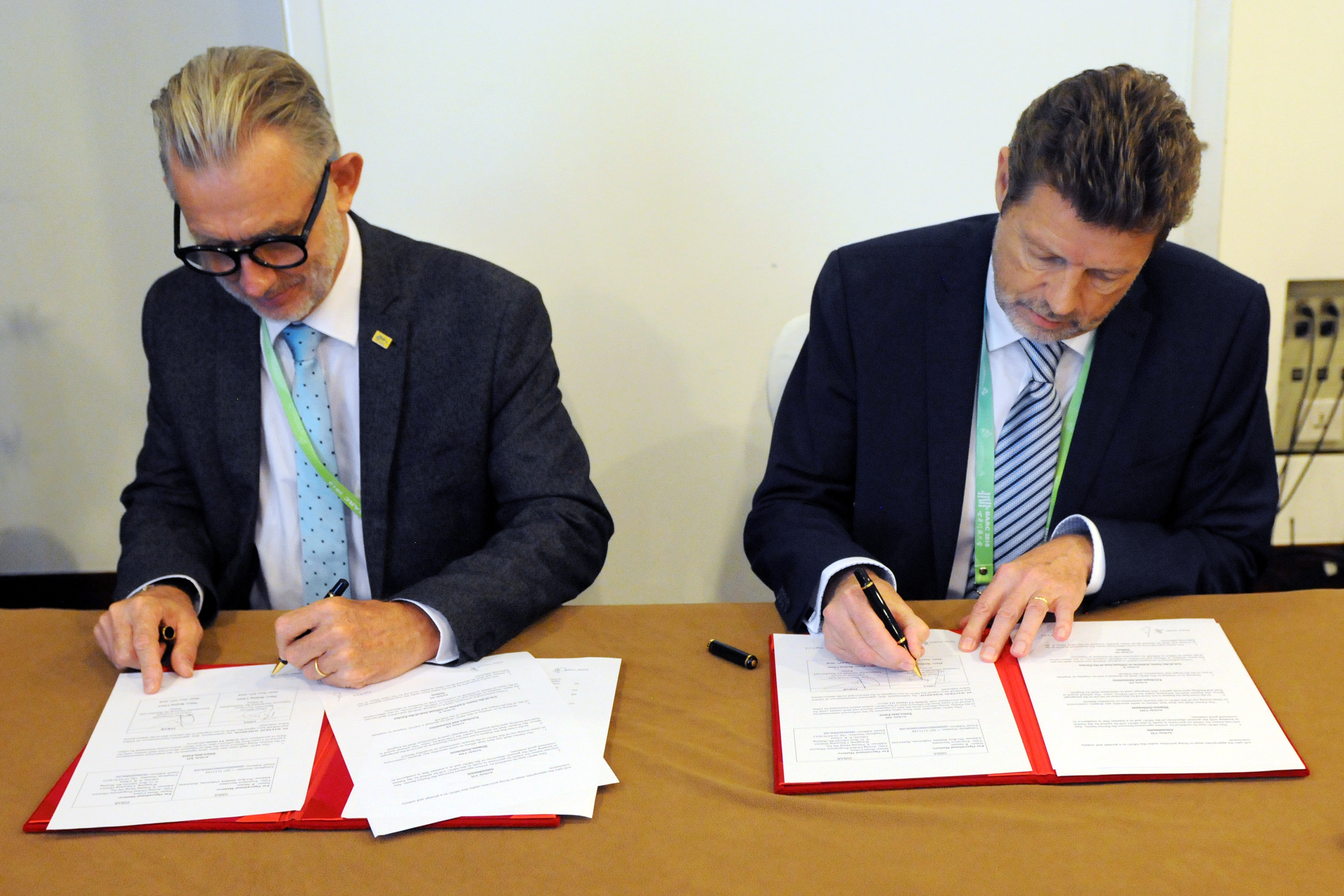
Signing MoU with Ruud Jansen, Executive Secretary, Gaborone Declaration for Sustainability in Africa
One concern about flying lots of people around he world and organising a major event is the carbon footprint this creates. I was very happy that we were able to offset all the CO2 produced by the Congress, through a contribution from the private sector to the China Green Carbon Fund. BARC 2018 was really carbon-neutral

Organising an event is mainly a logistics activity, and an event is only useful if it provides impact and it makes a difference. There is no point in doing great things if we cannot share the lessons learned, and I believe that BARC 2018 was one of the most important communications tools that INBAR had at its disposal in 2018. I was therefore thrilled that we had a lot of coverage, both in Chinese media and in international press.

We had hundreds of Chinese media reports, including Xinhua, China Daily, and Chinese video channels CGTN and CCTV, as well as local media from BARC strategic partners Yong’an, Meishan and Yibin.
The most relevant English language reports about BARC 2018 are listed here:
- SciDev, ‘Bamboo can power sustainable development’ https://www.scidev.net/asia-pacific/climate-change/opinion/bamboo-can-power-sustainable-development.html
- International Press Service, ‘Bamboo: A Sustainability Powerhouse’: http://www.ipsnews.net/2018/06/bamboo-sustainability-powerhouse/
- Forests, Trees and Agroforestry, ‘Realizing bamboo and rattan’s full potential: An interview with INBAR Director General Hans Friederich’: http://foreststreesagroforestry.org/realizing-bamboo-and-rattans-full-potential-an-interview-with-inbar-director-general-hans-friederich
There is a lot of information on the INBAR website as well. This includes general stories about BARC 2018 as well as specific reports or interviews. And we have hundreds of photos. One of the young interns that helped me during BARC 2018, is now working with us to catalogue all the videos, presentations, speeches and other written products of the Congress. A mammoth task.
Talking about interns – we had a large number of super volunteers at the Congress, and I was happy to recognise them by given a token of appreciation to one representative.
In my closing remarks to participants at the end of the Congress, I stressed that: “Bamboo and rattan are no longer ‘poor man’s timber’ – they are truly ‘green gold’, and their applications for sustainable development and environmental protection go hand-in-hand with their industrial applications and use by the private sector.”
What a fantastic experience this was!

0 comments
Write a comment